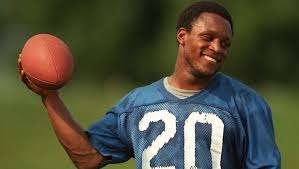In the rich tapestry of NFL history, few names evoke the kind of awe, reverence, and mystery that Barry Sanders does. A player who seemed to glide rather than run, disappear rather than dodge, and who made some of the league’s greatest defenders look like amateurs was unlike anyone the game had seen before, or since.
Yet, beyond the jaw-dropping highlights and gaudy statistics lies a deeper story: one of humility, brilliance, and quiet disruption. Barry Sanders didn’t just dominate the NFL he changed the way we think about the running back position, all without ever raising his voice.
The Early Years: A Star in the Shadows
Born in Wichita, Kansas in 1968, Barry Sanders wasn’t even the starting running back in high school until his senior year. Overshadowed by more physically imposing peers, he was often overlooked by recruiters. But when given his shot, he exploded onto the scene, rushing for over 1,300 yards in just seven games his senior year.
He went on to play college football at Oklahoma State University, where in 1988 he had arguably the greatest season in college football history rushing for 2,628 yards and 37 touchdowns, earning the Heisman Trophy and setting multiple NCAA records. Despite his accolades, Sanders remained humble, rarely celebrating or drawing attention to himself. That humility would become a defining trait throughout his professional career.
The NFL Arrival: Instant Impact
Drafted third overall by the Detroit Lions in 1989, Sanders didn’t take long to prove he belonged. In his rookie season, he rushed for 1,470 yards and 14 touchdowns, winning the NFL Offensive Rookie of the Year award.
What set him apart wasn’t just the numbers it was the way he got them. Watching Sanders run was like watching a magician. Defenders would swarm, angles would close, and just when it looked like the play was over, Barry would spin, cut, and burst into open field. He made the impossible look routine.
And yet, he never celebrated. No dancing. No chest-pounding. No trash talk. Just a quiet jog back to the huddle, ball in hand, ready for the next play.
The Secret of Sanders’ Greatness
So what was Barry Sanders’ secret?
It wasn’t brute strength. It wasn’t elite straight-line speed though he was fast. And it certainly wasn’t showmanship. His greatness lay in his vision, balance, and ability to make real-time decisions faster than any player on the field.
He possessed an almost preternatural sense of space he could see openings before they existed, anticipate defender movements, and alter his path without losing momentum. He ran like water, flowing around obstacles rather than crashing through them.
This instinctive style of play made Sanders a nightmare for defenses. Traditional tackling techniques didn’t work. Film study couldn’t prepare defenders for what he’d do, because often, even he didn’t know what he was going to do until the play unfolded. He reacted in real time, turning broken plays into touchdowns.
That was the true sport secret behind Barry Sanders: he didn’t follow the play he created it.
Changing the Game
Before Barry Sanders, the ideal running back was often a bruiser someone who could wear down a defense with 25-30 carries and grind out tough yards between the tackles. Sanders flipped that narrative.
He showed that a running back could be an artist someone whose value wasn’t just measured in yards per carry, but in the fear he instilled in a defense. His success opened the door for a new generation of elusive, dual-threat backs who thrived in open space players like LaDainian Tomlinson, LeSean McCoy, and Christian McCaffrey all owe something to the path Sanders paved.
Sanders also elevated the importance of offensive line adaptability and play design. Coaches had to begin scheming not just for traditional power runs, but for ways to get their elusive playmakers into open space changing the way the position was understood and utilized across the league.
The Exit That Shocked the World
Perhaps nothing defines Barry Sanders more than the way he ended his career.
In 1999, after ten seasons, ten Pro Bowls, and over 15,000 rushing yards, Sanders abruptly retired just 1,457 yards short of breaking Walter Payton’s all-time rushing record. There was no farewell tour, no press conference, no dramatic send-off. Just a short letter, faxed from London.
To this day, fans and analysts debate why he walked away. Some say it was frustration with the Detroit Lions’ lack of playoff success. Others believe it was the physical and emotional toll of carrying a franchise for a decade. But the truth may be simpler: Barry Sanders had nothing left to prove.
His legacy wasn’t built on longevity or records. It was built on excellence, integrity, and a refusal to compromise who he was.
Legacy of a Legend
Today, Barry Sanders is enshrined in the Pro Football Hall of Fame. He remains one of the most beloved figures in NFL history not just for what he accomplished, but for how he carried himself.
He never chased attention, yet he remains unforgettable. He never sought to define the game, yet he reshaped it. And he never sought fame, yet his name is spoken with reverence by players, coaches, and fans alike.
Barry Sanders didn’t roar. He whispered and in doing so, became a storm.

